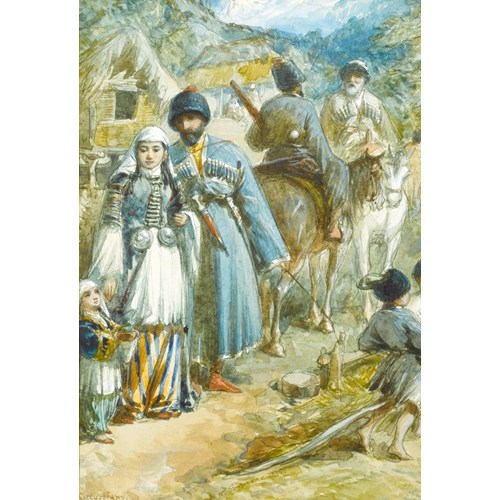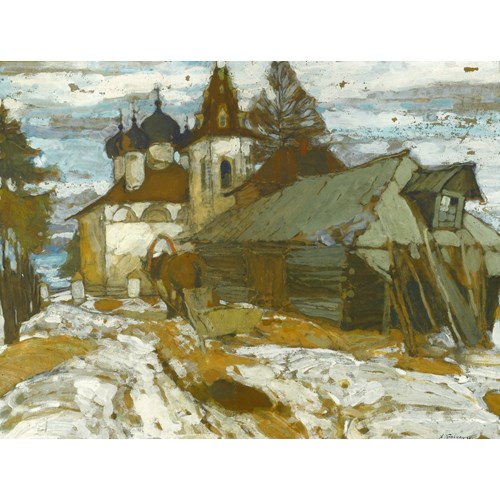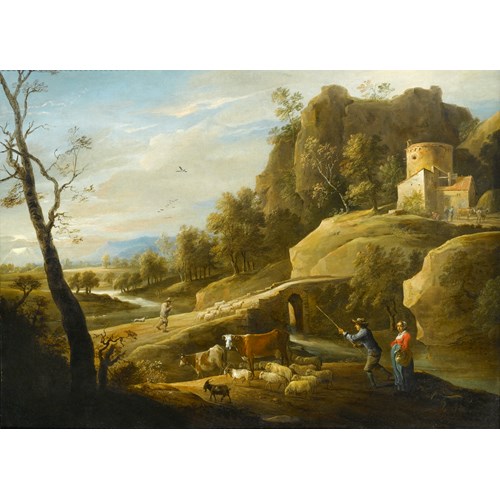Marketplace
A Mountainous Landscape with a Horseman by a Tower
Paul von Franken
A Mountainous Landscape with a Horseman by a Tower
Date 1854
Period 1850-1900, 19th century
Origin Germany
Medium Oil on canvas
Dimension 44 x 63 cm (17³/₈ x 24³/₄ inches)
Completed in 1854, the present painting depicts a horseman in conversation with a standing, armed figure outside a watchtower on the edge of a wide flowing river. In the background, a large snow-capped mountain range, undoubtedly the Caucasus, extends across the horizon. The watchtower, a guard positioned on the top tier, is situated alongside a small thatched hut. A large, dense sweeping mass of clouds hang above the water on the left, whilst a creeping mist floats over the nearby mountains. Furthermore, the rapid pace of the river is evident in the swirls of whipped water that appear near the riverbank.
Although the location of this scene is not revealed by the artist, it may possibly be a fictional scene from the Caucasian War (1817-1864), a period frequently illustrated by Paul von Franken. During the lengthy and sporadic war, the Russian Empire invaded the Caucasus looking to make territorial gains. Despite encountering considerable military obstacles in fierce combat from the local Muslim tribes and the rugged, mountainous terrain, the war ended with the annexation of areas of the northern Caucasus to Russia.
The standing man appears to be wearing Caucasian dress with a kindjal tucked into his belt, and breast cartridges suggested with white marks of paint. This was a traditional dress of people from the Caucasus, most usually associated with Circassians as the coat is typically referred to as a ‘Circassian coat’. The belt was an essential part of Caucasian dress, as pistols and kindjals were usually attached to it. Similar belts were also worn in Chechnya and Dagestan. The kindjal was a double-edged dagger and secondary weapon that had been used in Georgia and the Caucasus since antiquity. From this identification, it is most likely that this scene depicts a small surveillance outpost of the anti-Russian resistance during these hostilities.
The present work is typical of von Franken’s views of the Caucasus, and he even repeated the motif of a guard tower in several of his works, including Watchtower in the Caucasus of 1865 (Private Collection). In this later work there are considerably more figures, but they are even less prominent against the dramatic landscape, serving as staffage to animate the stunning surrounding vista. Von Franken should be considered as primarily a landscape painter, and in the rivers, lakes and mountains of the Caucasus he found constant inspiration throughout his artistic career.
Von Franken, a genre and landscape painter, was born in 1819 in Oberbachem near Godesberg. After starting his training at the Dusseldorf Academy of Arts in 1823, he spent the period from 1842 to 1845 in Brussels and Antwerp, and exhibited at the Dresden Academy in 1846. He later worked as a teacher, where he met his future wife Helene Korber who was from Jelgava (Mitau) in Latvia. Following their wedding in 1852 the couple moved to Jelgava after a short stay in Paris, and von Franken exhibited in Riga in 1854.
In 1853 the von Frankens moved to Tiflis, spending time in St. Petersburg and Moscow on the way. Whilst in Moscow, von Franken applied for a passport in which he was named ‘Paul Franken, Prussian subject’. It was during this period in Eastern Europe that von Franken became deeply fascinated with the people, culture and landscape of the Caucasus. Leaving his wife in Tiflis, in 1861 von Franken returned to Dusseldorf where he remained until his death. However he frequently returned to the Caucasus to paint, draw and study, and it was undoubtedly a favourite and inspiring location for von Franken.
Although the location of this scene is not revealed by the artist, it may possibly be a fictional scene from the Caucasian War (1817-1864), a period frequently illustrated by Paul von Franken. During the lengthy and sporadic war, the Russian Empire invaded the Caucasus looking to make territorial gains. Despite encountering considerable military obstacles in fierce combat from the local Muslim tribes and the rugged, mountainous terrain, the war ended with the annexation of areas of the northern Caucasus to Russia.
The standing man appears to be wearing Caucasian dress with a kindjal tucked into his belt, and breast cartridges suggested with white marks of paint. This was a traditional dress of people from the Caucasus, most usually associated with Circassians as the coat is typically referred to as a ‘Circassian coat’. The belt was an essential part of Caucasian dress, as pistols and kindjals were usually attached to it. Similar belts were also worn in Chechnya and Dagestan. The kindjal was a double-edged dagger and secondary weapon that had been used in Georgia and the Caucasus since antiquity. From this identification, it is most likely that this scene depicts a small surveillance outpost of the anti-Russian resistance during these hostilities.
The present work is typical of von Franken’s views of the Caucasus, and he even repeated the motif of a guard tower in several of his works, including Watchtower in the Caucasus of 1865 (Private Collection). In this later work there are considerably more figures, but they are even less prominent against the dramatic landscape, serving as staffage to animate the stunning surrounding vista. Von Franken should be considered as primarily a landscape painter, and in the rivers, lakes and mountains of the Caucasus he found constant inspiration throughout his artistic career.
Von Franken, a genre and landscape painter, was born in 1819 in Oberbachem near Godesberg. After starting his training at the Dusseldorf Academy of Arts in 1823, he spent the period from 1842 to 1845 in Brussels and Antwerp, and exhibited at the Dresden Academy in 1846. He later worked as a teacher, where he met his future wife Helene Korber who was from Jelgava (Mitau) in Latvia. Following their wedding in 1852 the couple moved to Jelgava after a short stay in Paris, and von Franken exhibited in Riga in 1854.
In 1853 the von Frankens moved to Tiflis, spending time in St. Petersburg and Moscow on the way. Whilst in Moscow, von Franken applied for a passport in which he was named ‘Paul Franken, Prussian subject’. It was during this period in Eastern Europe that von Franken became deeply fascinated with the people, culture and landscape of the Caucasus. Leaving his wife in Tiflis, in 1861 von Franken returned to Dusseldorf where he remained until his death. However he frequently returned to the Caucasus to paint, draw and study, and it was undoubtedly a favourite and inspiring location for von Franken.
Date: 1854
Period: 1850-1900, 19th century
Origin: Germany
Medium: Oil on canvas
Signature: Signed with monogram and dated ‘1854’ (lower right).
Dimension: 44 x 63 cm (17³/₈ x 24³/₄ inches)
More artworks from the Gallery









